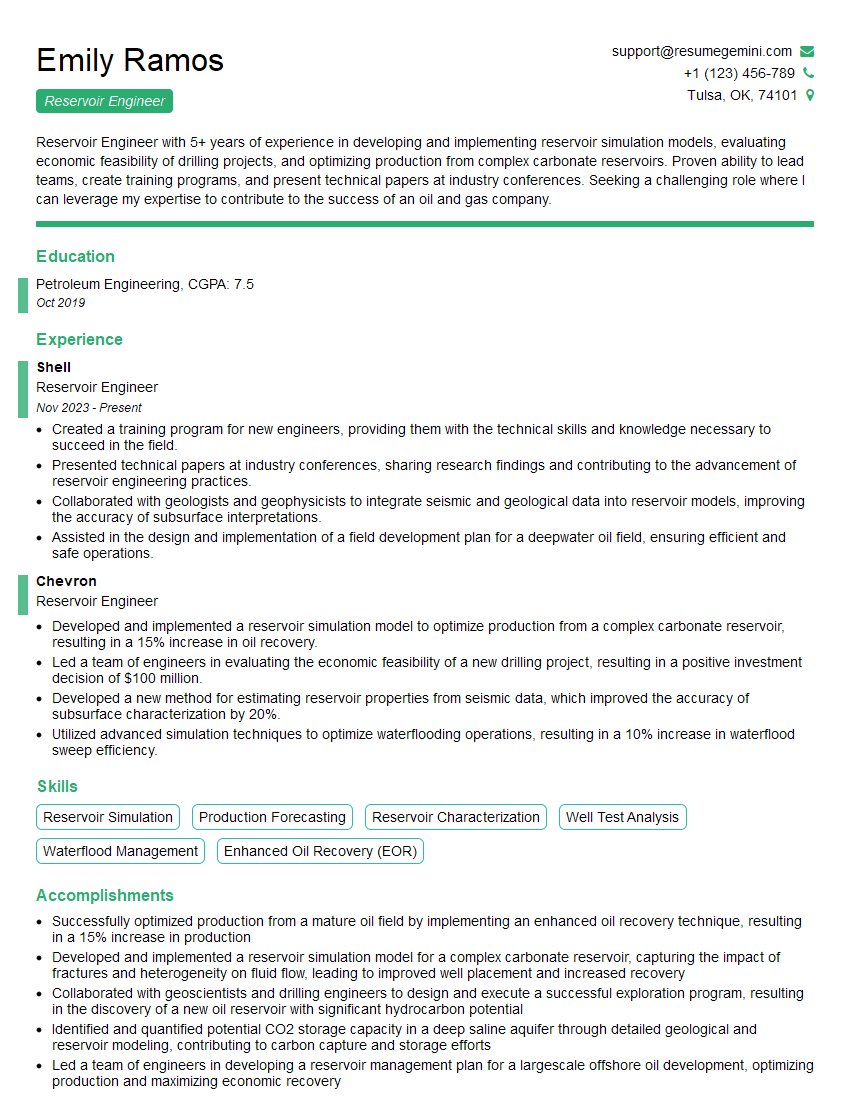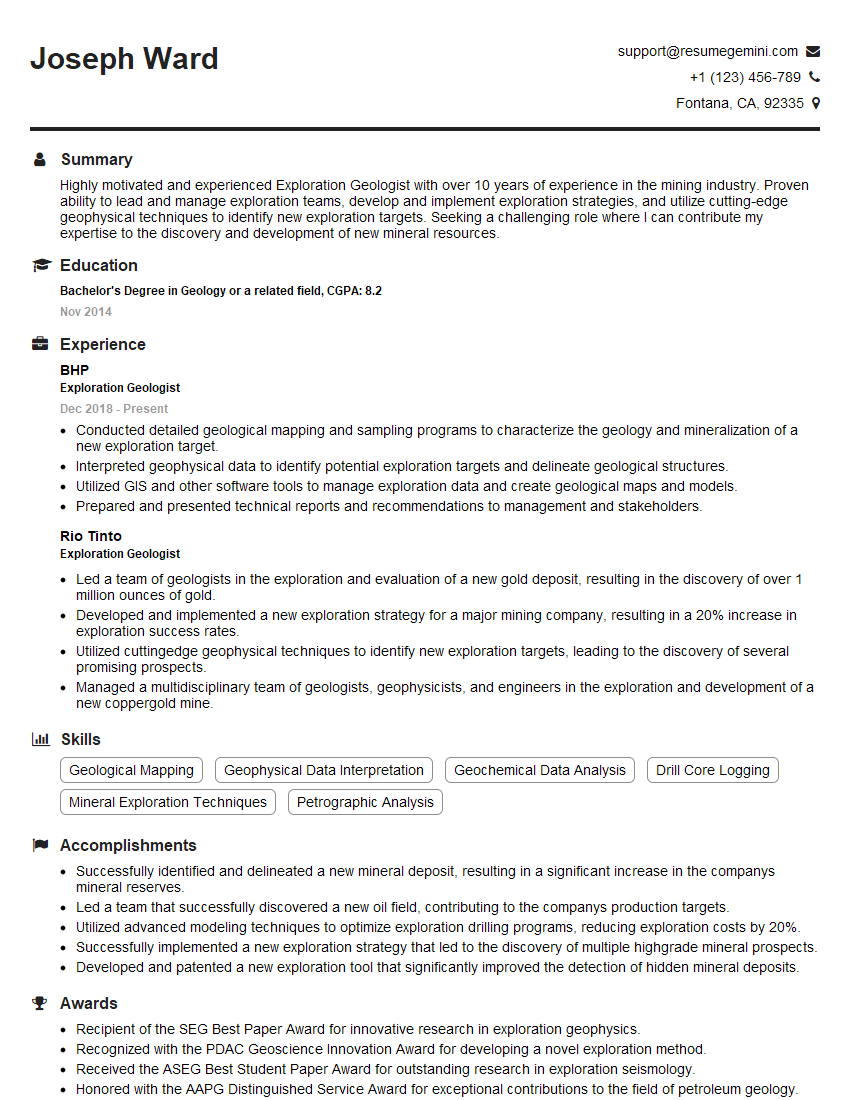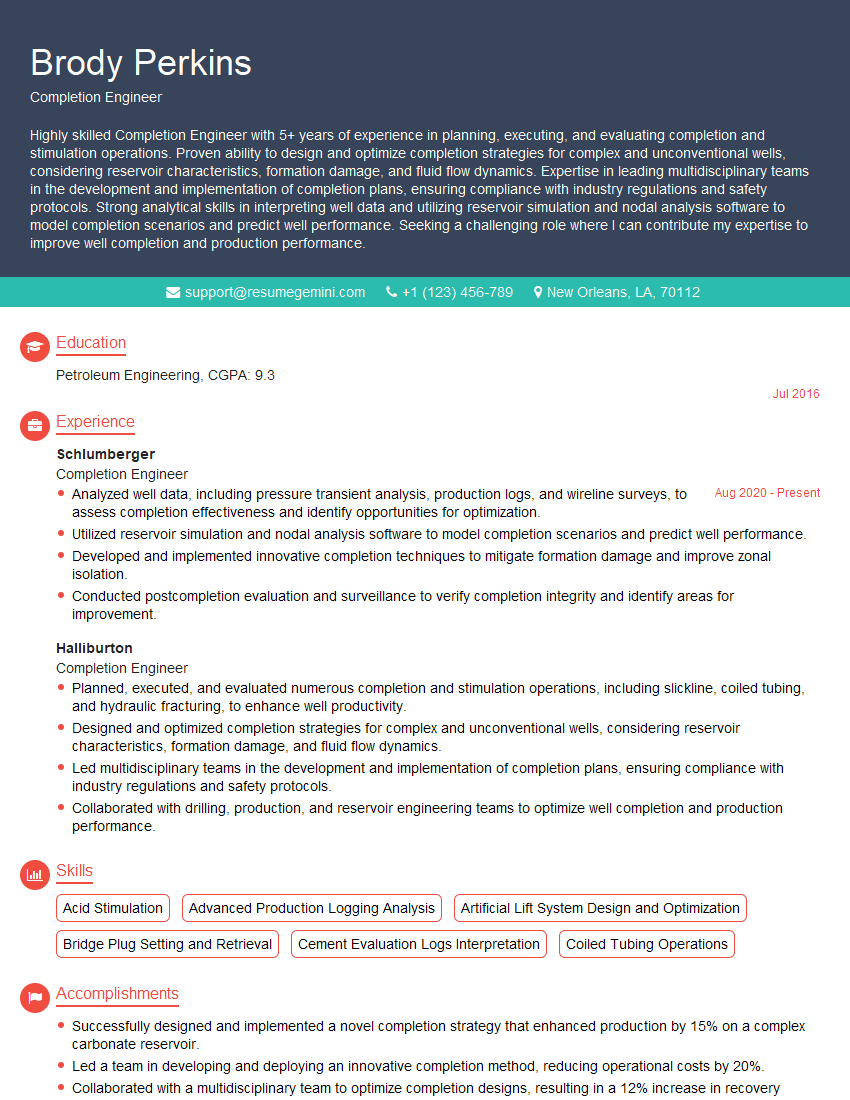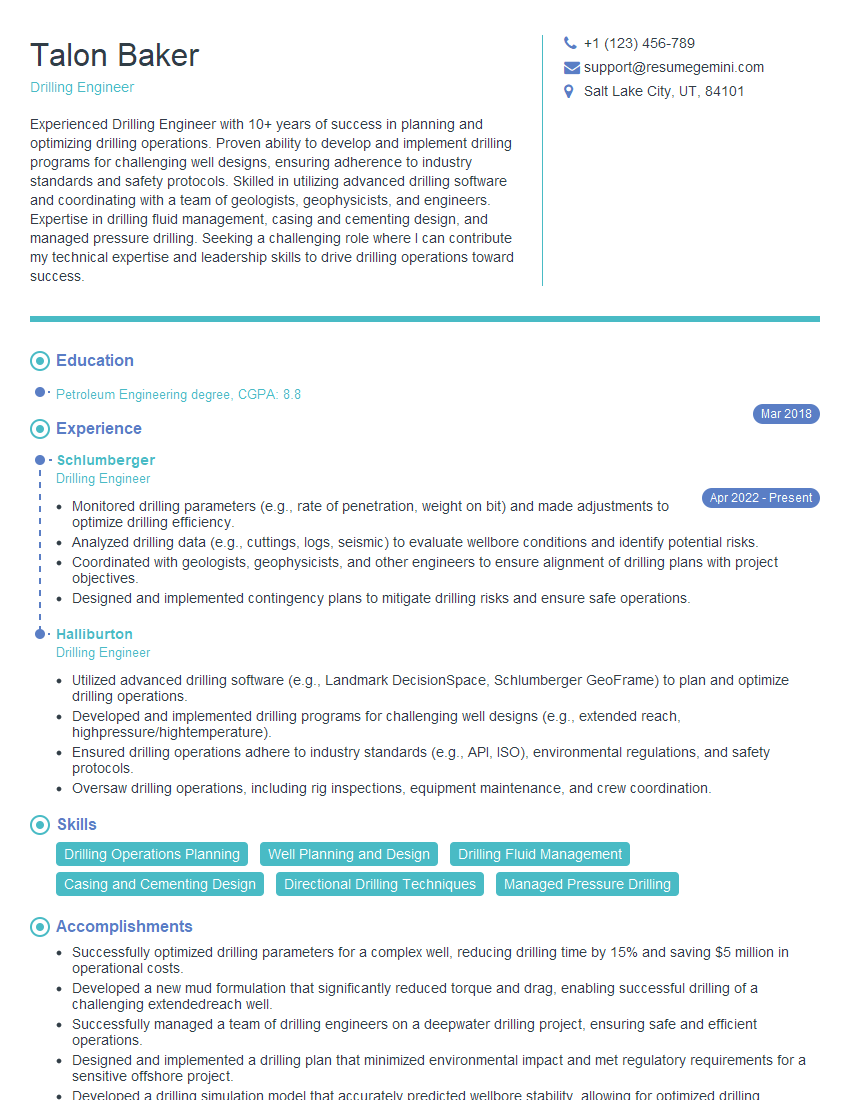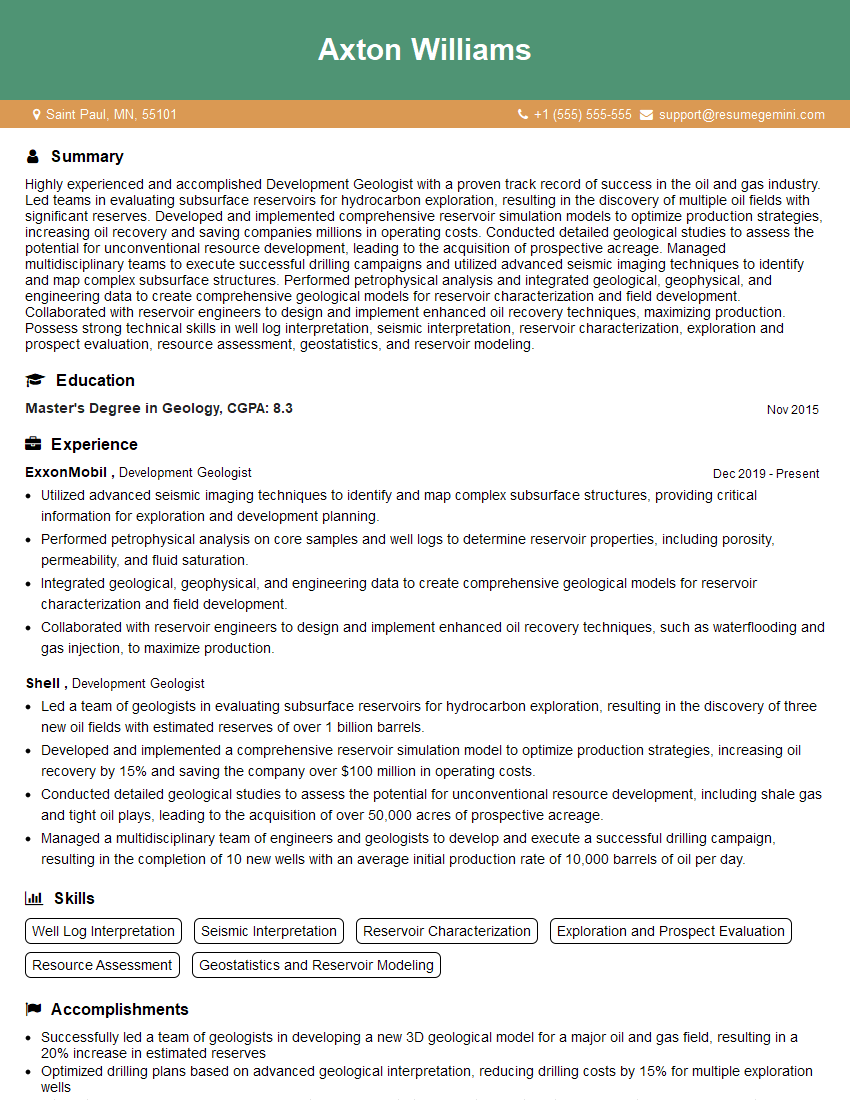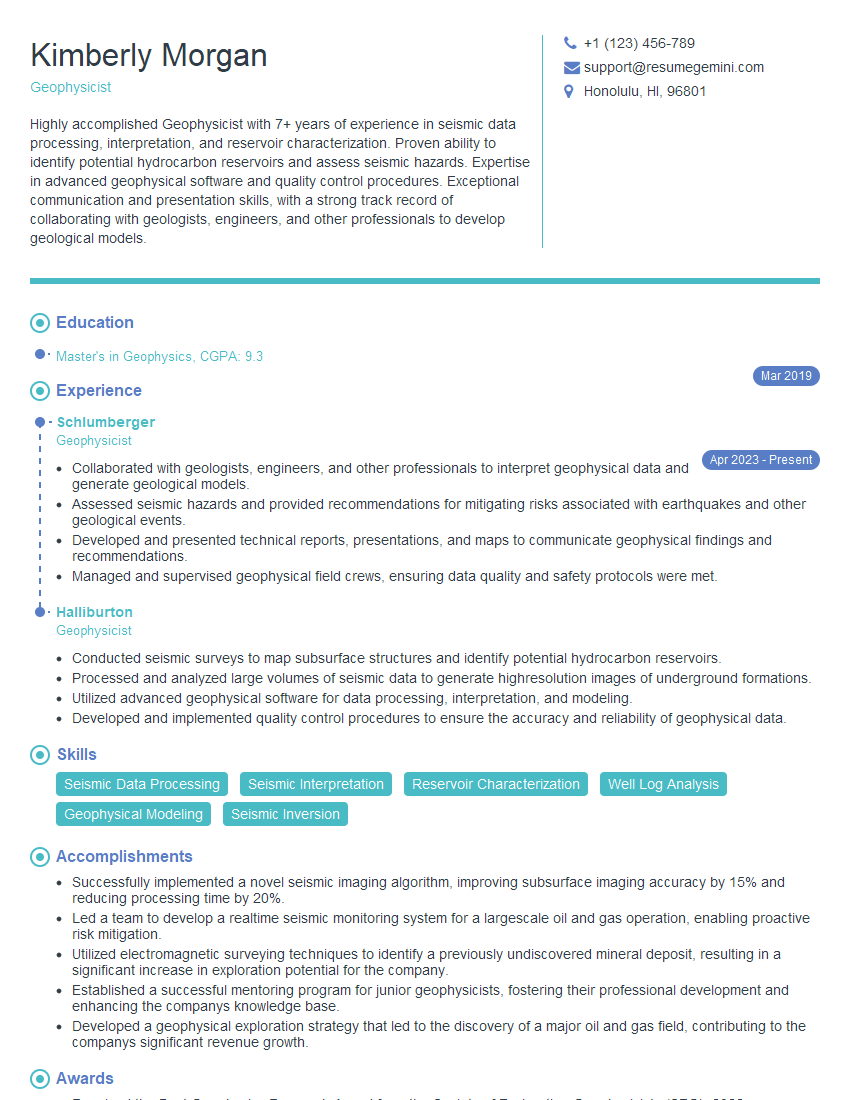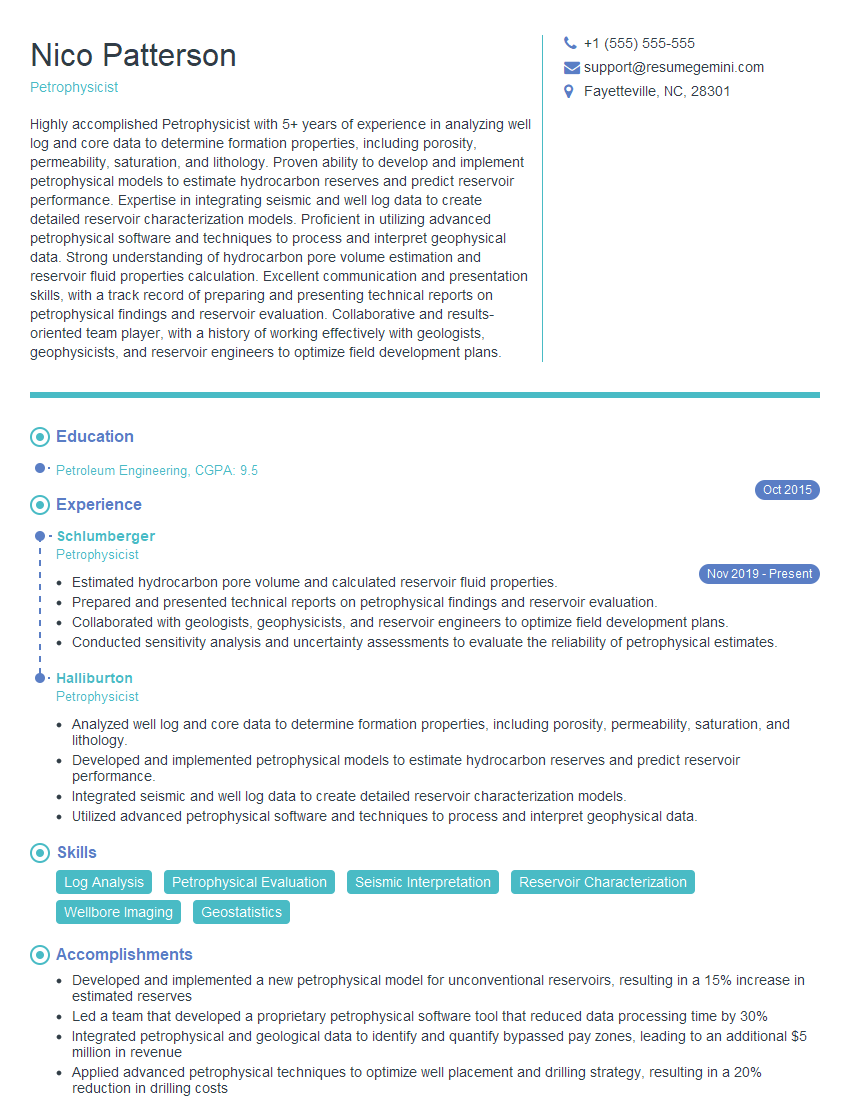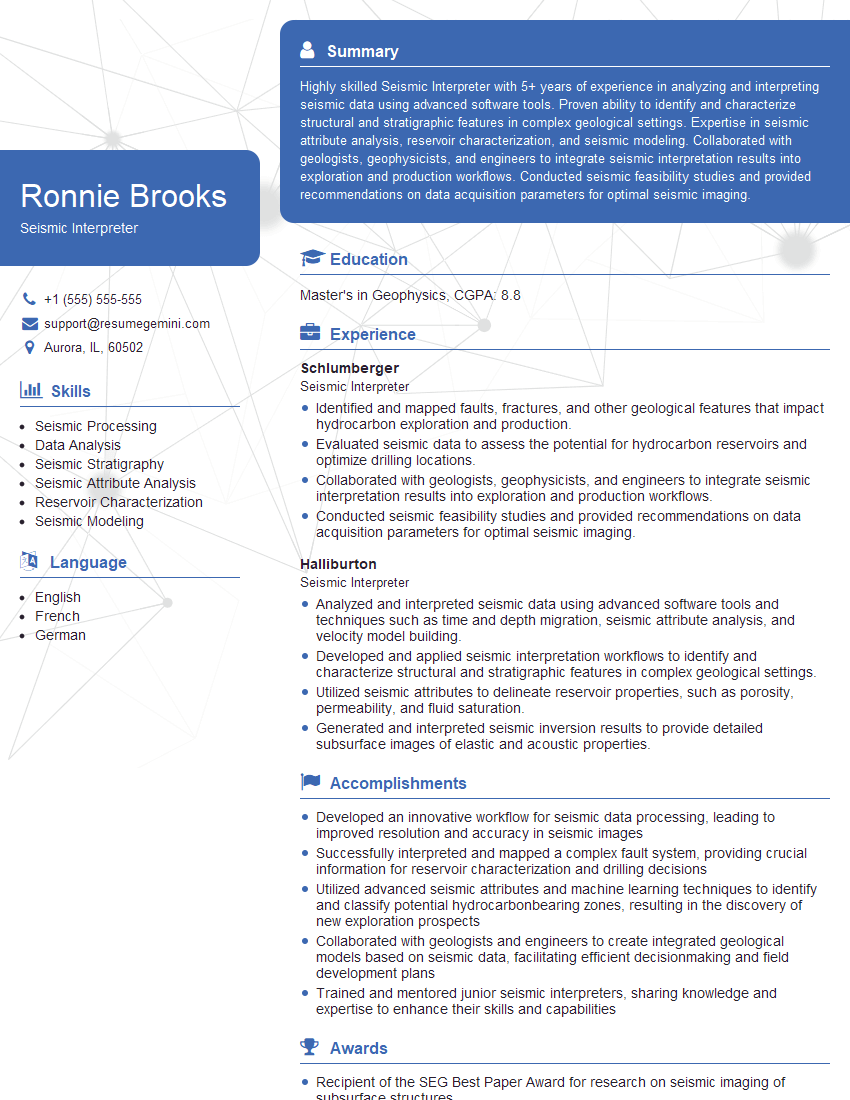Every successful interview starts with knowing what to expect. In this blog, we’ll take you through the top Software Proficiency (e.g., Petrel, Paradigm, Schlumberger) interview questions, breaking them down with expert tips to help you deliver impactful answers. Step into your next interview fully prepared and ready to succeed.
Questions Asked in Software Proficiency (e.g., Petrel, Paradigm, Schlumberger) Interview
Q 1. Explain the workflow for building a 3D geological model in Petrel.
Building a 3D geological model in Petrel is a multi-step process that involves integrating various data types to create a realistic representation of the subsurface. Think of it like assembling a 3D puzzle, where each piece is a different data type.
- Data Integration: This is the foundational step. We start by importing seismic data (often in SEG-Y format), well logs (including GR, density, porosity, and resistivity), and geological interpretations (faults, horizons). Imagine this as gathering all the puzzle pieces.
- Horizon Interpretation: We use seismic data to identify and map key geological horizons, representing significant changes in rock properties. This is like identifying the major sections of the puzzle.
- Fault Interpretation: We delineate faults and their geometry using seismic interpretation techniques. Faults are crucial as they significantly influence reservoir properties and fluid flow. This is akin to defining the major breaks and discontinuities in the puzzle.
- Well Log Editing and Calibration: We carefully edit and calibrate well logs to ensure consistency and accuracy. This involves removing noisy data and aligning logs to the correct horizons. This is like checking that all the pieces are correctly aligned and shaped.
- Property Modeling: We use various techniques to interpolate the well log data between wells to create 3D property models (porosity, permeability, saturation, etc.). This is where we start to fill in the puzzle with the correct pieces.
- Facies Modeling (Optional): Based on well log data and geological understanding, we can create a 3D facies model, representing different rock types. This adds another level of detail to the puzzle, giving each section unique characteristics.
- Model Validation: Finally, we validate the model by comparing its predictions to available data, making adjustments as needed. This is like checking if the assembled puzzle matches the image on the box.
For example, in a recent project, we used Petrel to build a model of a turbidite reservoir. The process involved carefully interpreting the complex seismic data to map out the channel system and then using well log data to populate the model with accurate rock properties. The resulting model was used to assess the reservoir’s potential and guide well placement decisions.
Q 2. Describe your experience with seismic interpretation in Paradigm.
My experience with seismic interpretation in Paradigm involves a wide range of techniques and workflows aimed at understanding subsurface geology from seismic reflection data. Paradigm’s suite offers powerful tools for visualizing and interpreting seismic data, from basic horizon picking to advanced attribute analysis.
I’m proficient in using various interpretation tools such as horizon tracking, fault interpretation, and seismic attribute analysis. I use these tools to identify key geological features like channels, faults, and stratigraphic layers. For instance, I’ve used coherence and curvature attributes to map faults and fractures effectively. These attributes help highlight subtle variations in seismic amplitude and phase, revealing structural details often invisible in conventional seismic sections.
In one project, we used Paradigm to interpret a 3D seismic survey of a carbonate reservoir. By employing advanced attribute analysis and integrating well log data, we identified several previously unknown structural features that significantly impacted our reservoir characterization and subsequent development planning. This resulted in a more accurate model that improved drilling success rates.
Q 3. How do you manage large datasets within Schlumberger’s software?
Schlumberger’s software, such as Petrel and its associated tools, employs several strategies to handle large datasets efficiently. These strategies are crucial because geophysical and geological data often reach terabyte scales.
- Data Subsetting: Instead of loading the entire dataset into memory, we selectively load only the relevant portion needed for a specific task. This is similar to only looking at the part of a map you need at a given time, instead of carrying the whole atlas.
- Data Compression: Schlumberger’s software utilizes various compression techniques to reduce the storage space and improve loading times. This reduces the file size without significant information loss.
- Database Management: Large datasets are typically stored in relational or geospatial databases, allowing efficient querying and retrieval of specific information. This is like having a well-organized library instead of a pile of papers.
- Distributed Computing: For extremely large datasets, parallel processing capabilities are leveraged to distribute the workload across multiple computer cores or even multiple computers, accelerating processing speed. This is akin to several workers completing a project faster than a single person.
- Data Visualization Optimization: Visualizing large datasets efficiently requires specialized techniques like progressive rendering, which allows for the gradual display of data as it’s loaded. This ensures that the user interface remains responsive.
In practice, I regularly work with large seismic volumes and well log datasets. Understanding the data management capabilities of the software is crucial to ensure efficient workflows and prevent bottlenecks.
Q 4. What are the key differences between Petrel and Paradigm in terms of reservoir simulation?
Petrel and Paradigm both offer reservoir simulation capabilities, but they differ in their approach and functionalities. Think of it as comparing two different cars – both get you to the destination but with different features and styles.
- Integration: Petrel’s reservoir simulation capabilities are more tightly integrated with its other functionalities (geology, geophysics, petrophysics). Paradigm’s reservoir simulation is often a separate module requiring more data transfer between different applications.
- Simulation Engines: Both use different simulation engines, which affect the accuracy, speed, and types of simulations they can run. The specific engine choices might influence the simulation’s computational requirements and result accuracy.
- Workflows: The workflows for setting up and running simulations can differ significantly. Petrel often presents a more integrated and streamlined workflow, whereas Paradigm’s might require more manual intervention.
- Advanced Features: Each platform might offer unique advanced features. For instance, one might excel in specific simulation types (e.g., compositional simulation) while the other might have better capabilities for coupled reservoir-geomechanical simulations.
In short, choosing between Petrel and Paradigm for reservoir simulation depends on the specific project requirements, available data, preferred workflow, and the need for specific advanced features. Both are powerful tools, but they offer different strengths and weaknesses.
Q 5. How would you troubleshoot a Petrel workflow error?
Troubleshooting a Petrel workflow error involves a systematic approach. It’s like debugging a computer program, where you need to pinpoint the source of the error.
- Identify the Error: Start by carefully reviewing the error message. What is the specific problem? What part of the workflow is failing?
- Check the Input Data: Examine the input data used in the workflow. Are there any inconsistencies, missing values, or corrupted files? Ensure the data formats are correct and compatible.
- Step-by-Step Execution: Execute the workflow step-by-step, checking the intermediate results at each stage. This helps isolate the step causing the error.
- Review the Workflow: Check the entire workflow for logical errors or inconsistencies. Are there any missing steps or incorrect parameters?
- Consult the Petrel Documentation: The Petrel documentation provides valuable information about troubleshooting common errors. Use the search function to find solutions to similar problems.
- Online Resources: Search online forums and communities for solutions. Others may have encountered similar issues.
- Petrel Support: If all else fails, contact Petrel support for assistance.
For instance, if you encounter an error during a property modeling workflow, you might need to check the quality of your well log data, the validity of the interpolation parameters, and the consistency of your horizons. Systematic investigation is key to resolving these types of issues.
Q 6. Describe your experience with well log analysis and interpretation using Petrel or Paradigm.
Well log analysis and interpretation are central to my workflow in both Petrel and Paradigm. These tools provide a comprehensive environment for interpreting various well logs to understand subsurface properties.
My experience includes processing, editing, and interpreting various logs such as gamma ray (GR), density, neutron porosity, resistivity, and sonic logs. I use these logs to identify lithology, porosity, permeability, and fluid saturation. I routinely use techniques such as:
- Log Editing: Cleaning noisy data, correcting for environmental effects, and standardizing logs.
- Cross-Plotting: Creating cross-plots of various logs to identify relationships and correlations between properties.
- Log Calculations: Calculating derived properties like effective porosity and water saturation.
- Facies Identification: Using log signatures to identify different rock types (facies).
- Log Calibration: Using core data and other information to calibrate logs and improve their accuracy.
For example, in a recent project, we used Petrel to analyze well logs from a gas reservoir. We used various log calculations and cross-plots to accurately determine gas saturation and delineate the gas-water contact. This information was crucial for estimating the reservoir’s reserves and optimizing production strategies.
Q 7. Explain the concept of facies modeling and your experience with it in Petrel or Paradigm.
Facies modeling is the process of creating a 3D representation of different rock types (facies) within a reservoir. It’s like creating a detailed map showing the distribution of various geological units. This is crucial for reservoir characterization and simulation.
My experience with facies modeling in Petrel and Paradigm primarily involves using techniques such as:
- Training Image Approach: Using well log data and other geological information to create a training image that represents the spatial distribution of facies.
- Stochastic Modeling: Employing stochastic algorithms to generate multiple equally likely realizations of the facies model, accounting for uncertainty. This provides a range of possible outcomes rather than a single deterministic prediction.
- Sequential Indicator Simulation (SIS): A common stochastic method that honors the training image and generates realistic facies distributions.
- Object-Based Modeling: Modeling facies based on geological objects such as channels and lobes.
In a recent project, we used Petrel to build a facies model of a fluvial reservoir. We employed SIS to generate multiple realizations of the model, reflecting the inherent uncertainty in the subsurface. The resulting facies model was used to improve our reservoir simulation and optimize production strategies, leading to a more accurate prediction of reservoir performance.
Q 8. How do you incorporate seismic data into your geological model?
Incorporating seismic data into a geological model is crucial for understanding subsurface structures and properties. Seismic data provides an image of the subsurface, revealing geological features like faults, folds, and stratigraphic variations that influence reservoir geometry and fluid flow. The process generally involves several steps:
- Seismic Interpretation: Geologists and geophysicists interpret seismic data to identify key geological features, horizons, and potential reservoir zones. This often involves using specialized software like Petrel or Paradigm to visualize and analyze seismic volumes, identify horizons, and map faults.
- Seismic Attribute Analysis: Extracting attributes like amplitude, frequency, and reflectivity from seismic data can provide insights into rock properties such as porosity and lithology. These attributes are then used to constrain the geological model.
- Depth Conversion: Seismic data is initially in time domain; however, for integration with well data and other geological information, it needs to be converted to depth using velocity models derived from well logs and other geophysical data.
- Geocellular Modeling: The interpreted horizons and attributes are incorporated into a 3D geocellular model. This model is built using software like Petrel or Paradigm, where seismic data guides the creation of realistic subsurface geometry, controlling the placement and shape of geological layers.
- Property Modeling: Seismic attributes are used to populate the geocellular model with properties like porosity, permeability, and water saturation. This often involves geostatistical techniques like kriging or sequential Gaussian simulation to interpolate the values between wells where seismic data is more continuous.
For example, in a project I worked on in the North Sea, we used 3D seismic data to accurately map a complex fault system that significantly impacted reservoir compartmentalization. The seismic interpretation helped us to refine the fault model and create a more accurate representation of the reservoir’s geometry, leading to a significant improvement in our production forecast.
Q 9. What are the limitations of using Petrel or Paradigm for reservoir simulation?
While Petrel and Paradigm are powerful tools for reservoir simulation, they do have limitations. These limitations often stem from the need to simplify complex subsurface processes to make them computationally tractable:
- Computational Cost: High-resolution reservoir simulations can be extremely computationally expensive, limiting the size and complexity of models that can be practically handled. This can necessitate simplifying the geological model or using less sophisticated numerical methods.
- Data Requirements: Reservoir simulation requires extensive input data, including accurate representations of geological properties (porosity, permeability, etc.), fluid properties, and boundary conditions. Lack of sufficient or high-quality data can limit the accuracy and reliability of simulation results.
- Model Simplifications: Real-world reservoirs are incredibly complex, with heterogeneous rock properties, intricate fracture networks, and complex fluid flow dynamics. Reservoir simulation software often requires simplifications, such as homogenizing rock properties or using simplified fluid models, that may not capture all relevant geological and physical processes.
- Uncertainty Quantification: Although both platforms offer capabilities for uncertainty analysis, handling uncertainty effectively can be challenging. Properly accounting for uncertainties in input parameters and model assumptions is crucial for producing reliable predictions. The computational cost associated with Monte Carlo simulations can be significant.
For instance, in a project involving a fractured carbonate reservoir, we faced challenges in accurately representing the complex fracture network within the simulation model using Petrel’s built-in tools. We had to employ external fracture modeling software and integrate the results carefully to achieve a reasonably accurate simulation.
Q 10. Describe your experience with history matching in reservoir simulation software.
History matching is a crucial step in reservoir simulation, where we adjust model parameters to match the historical production data. This iterative process helps calibrate the model and improve its predictive capabilities. My experience involves using both Petrel and Paradigm’s built-in history-matching tools, often involving a combination of manual adjustments and automated optimization techniques:
- Data Preparation: The process begins with careful compilation and cleaning of historical production data (e.g., oil/gas/water rates, pressure data, and water cut). Data quality is paramount here.
- Parameter Selection: We identify key model parameters that significantly influence production, such as permeability, porosity, and relative permeability curves. These parameters are adjusted during history matching.
- Optimization Techniques: Several optimization algorithms are used, such as gradient-based methods or evolutionary algorithms, to efficiently explore the parameter space and find the best-fit model. Software often has built-in tools for this purpose.
- Model Evaluation: The quality of the history match is assessed using statistical measures such as root mean square error (RMSE) or correlation coefficients. Visual inspection of the match between simulated and actual production data is also critical.
- Iterative Adjustment: History matching is often an iterative process, with repeated adjustments of model parameters and re-runs of the simulation until a satisfactory match is achieved.
In one project, I used a genetic algorithm implemented within Paradigm to history match a gas condensate reservoir. The algorithm efficiently navigated the vast parameter space, resulting in a model that accurately reproduced the observed pressure and production data, improving the confidence in our future production forecasts.
Q 11. How do you validate your geological model?
Validating a geological model is a critical step to ensure it accurately represents the subsurface reality. This involves comparing model predictions with independent data sources and assessing the model’s consistency and reliability:
- Well Log Data Comparison: Comparing modeled rock properties (porosity, permeability) with measured values from well logs is fundamental. Discrepancies highlight areas where the model needs refinement.
- Seismic Data Validation: Comparing the model’s geometry with seismic interpretations ensures consistency. Seismic attributes can also be used for validation against the properties predicted by the model.
- Production Data Analysis: Comparing simulated production data with actual historical production data is crucial. A good history match is a strong indicator of model validity.
- Analogue Studies: Comparing the model with similar reservoirs and geological settings helps assess the plausibility of the model’s interpretation.
- Sensitivity Analysis: Exploring the sensitivity of model predictions to variations in input parameters highlights potential uncertainties and identifies critical parameters that require more accurate estimation.
For instance, in a project concerning an offshore oil field, we used 4D seismic data to validate our model. By comparing the simulated changes in pressure and saturation with the observed changes in seismic attributes over time, we confirmed the model’s ability to accurately simulate reservoir flow dynamics.
Q 12. Explain your experience with uncertainty analysis in reservoir modeling.
Uncertainty analysis is critical in reservoir modeling, as it acknowledges the inherent uncertainties in input data and model assumptions. This helps quantify the range of possible outcomes and improves decision-making under uncertainty:
- Probabilistic Methods: Techniques such as Monte Carlo simulation are used to sample the input parameter space and generate multiple realizations of the geological model. Each realization is then simulated, yielding a range of possible production outcomes.
- Sensitivity Analysis: Identifying the most sensitive parameters helps focus efforts on obtaining more accurate estimations of these parameters, reducing overall uncertainty.
- Geostatistical Modeling: Geostatistical methods inherently incorporate uncertainty through the use of variograms and other statistical measures. This allows the generation of multiple equally likely realizations of the reservoir properties.
- Ensemble Forecasting: Using the multiple simulation results from uncertainty analysis to create a range of possible future scenarios, allowing for a more robust assessment of project risks and uncertainties.
In a recent project, we used Monte Carlo simulation to assess the uncertainty in a gas reservoir’s ultimate recovery. The results showed a significant range of possible outcomes, highlighting the need for robust risk management strategies and contingency planning.
Q 13. How would you handle inconsistent data within your geological model?
Handling inconsistent data is a common challenge in geological modeling. It requires careful investigation and appropriate strategies to reconcile the discrepancies and create a consistent model:
- Data Quality Control: A thorough review of all data sources is crucial, identifying errors, outliers, and inconsistencies. This often involves checking data validity, completeness, and accuracy.
- Data Reconciliation: Techniques like data integration and geostatistical methods can help reconcile inconsistencies between different data sets. For example, soft data (interpretations) can be integrated with hard data (well logs) to create a more consistent representation.
- Weighting of Data: Assigning weights to different data sources based on their reliability and accuracy is an important step. For example, well log data might be weighted higher than less reliable seismic interpretations.
- Expert Judgment: In situations where inconsistencies remain despite data reconciliation, expert geological judgment is often necessary to make informed decisions about which data to prioritize or how to resolve conflicts.
- Sensitivity Analysis: After resolving inconsistencies, a sensitivity analysis can help determine how much the inconsistencies affect the final model and the degree of uncertainty introduced.
In one project, we encountered conflicting interpretations of a fault system from seismic and well data. By carefully analyzing the data, and consulting with experienced geologists, we managed to resolve the discrepancy and arrive at a more consistent and plausible interpretation, enhancing the accuracy of the overall model.
Q 14. Describe your experience with different gridding techniques in reservoir simulation.
Gridding techniques are crucial in reservoir simulation, defining the spatial discretization of the reservoir model. The choice of gridding technique significantly impacts the accuracy, computational efficiency, and the ability to represent geological features. My experience includes using various techniques in Petrel and Paradigm:
- Structured Grids: These grids consist of regularly spaced cells, forming a rectangular or hexahedral mesh. They are computationally efficient but struggle with complex reservoir geometry. They may require overly fine grids to accurately represent features.
- Unstructured Grids: These grids use irregularly shaped cells, allowing greater flexibility in representing complex geological features such as faults and channels. This often comes at the expense of increased computational cost.
- Hybrid Grids: A combination of structured and unstructured grids can be used to balance computational efficiency and geometric accuracy. This approach can be advantageous in situations with both simple and complex geometries.
- Adaptive Mesh Refinement (AMR): This technique uses a finer grid resolution in areas of high complexity or gradients, and coarser resolution in areas with relatively uniform properties, optimizing computational efficiency without sacrificing accuracy.
For example, in a fractured reservoir simulation, we employed an unstructured grid in Paradigm to accurately represent the complex fracture network. This allowed us to better capture the impact of fractures on fluid flow, which would have been impossible with a simpler structured grid.
Q 15. What are the different types of reservoir simulation models and their applications?
Reservoir simulation models are mathematical representations of subsurface reservoirs used to predict their behavior under various scenarios. They are crucial for optimizing oil and gas production. Different types cater to specific needs and complexities:
- Black-oil models: These are the simplest, assuming oil, gas, and water are incompressible and have constant properties. They’re great for initial screening and quick estimations but lack the accuracy for complex reservoirs.
- Compositional models: These models account for the varying compositions of hydrocarbon phases (oil, gas, etc.) and their changes with pressure and temperature. This level of detail is vital for understanding volatile oil reservoirs or gas condensate reservoirs, where phase changes significantly impact production.
- Thermal models: These are more complex, considering heat transfer within the reservoir. They are necessary for steam injection projects or heavy oil recovery where temperature plays a critical role in the fluid behavior.
- Chemical flooding models: These models simulate the injection of chemicals like polymers or surfactants to enhance oil recovery, factoring in the chemical reactions and their impact on fluid properties and flow.
For example, a black-oil model might suffice for a preliminary feasibility study of a mature oil reservoir with relatively stable conditions, while a compositional model would be essential for a gas condensate field where accurate prediction of retrograde condensation is crucial.
Career Expert Tips:
- Ace those interviews! Prepare effectively by reviewing the Top 50 Most Common Interview Questions on ResumeGemini.
- Navigate your job search with confidence! Explore a wide range of Career Tips on ResumeGemini. Learn about common challenges and recommendations to overcome them.
- Craft the perfect resume! Master the Art of Resume Writing with ResumeGemini’s guide. Showcase your unique qualifications and achievements effectively.
- Don’t miss out on holiday savings! Build your dream resume with ResumeGemini’s ATS optimized templates.
Q 16. How do you choose the appropriate reservoir simulation model for a specific problem?
Choosing the right reservoir simulation model hinges on several factors. It’s not a one-size-fits-all solution.
- Reservoir complexity: Simple reservoirs might only need a black-oil model; complex reservoirs with phase changes or significant thermal effects necessitate compositional or thermal models.
- Project goals: A quick feasibility study demands a simpler, faster model. Detailed reservoir management requires a highly accurate but potentially slower model.
- Data availability: Sophisticated models require more input data; if data is limited, a simpler model becomes more practical.
- Computational resources: Complex models demand significant computational power and time. The available resources constrain the model selection.
- Project budget: The cost associated with running and analyzing simulations scales with model complexity.
Imagine you’re evaluating a new offshore field with a suspected gas condensate reservoir. A compositional model is mandatory to accurately predict the phase behavior and subsequent production performance. Conversely, for a mature water-flooding operation, a black-oil model could suffice if the primary goal is to optimize water injection rates.
Q 17. Explain the concept of relative permeability and its importance in reservoir simulation.
Relative permeability describes the ability of a fluid (oil, water, or gas) to flow through a porous medium in the presence of other fluids. It’s a crucial parameter because it quantifies how the presence of one fluid impacts the flow of another. Imagine a sponge saturated with water; adding oil doesn’t immediately displace all the water. The relative permeability captures this interaction.
It’s expressed as a fraction between 0 and 1. A relative permeability of 1 means the fluid flows freely, while 0 means no flow. Relative permeability curves are commonly used to depict these relationships. These curves are typically generated from laboratory core analysis.
In reservoir simulation, relative permeability is vital because it governs the fluid distribution and flow patterns within the reservoir, directly affecting production forecasts. Accurate relative permeability data is crucial for predicting oil recovery factors.
Q 18. Describe your experience with fluid flow simulation in reservoir modeling software.
I have extensive experience with fluid flow simulation in various reservoir modeling software, including Petrel, Paradigm, and Schlumberger Eclipse. My experience encompasses building and running reservoir simulation models from scratch, incorporating data from various sources, and analyzing the results to improve production strategies.
In Petrel, for example, I’ve routinely used the reservoir simulator to perform history matching, adjusting model parameters to align simulation results with historical production data. This helps to improve the model’s predictive capabilities. In Paradigm, I’ve focused on utilizing advanced compositional modeling capabilities to understand phase behavior in complex gas reservoirs. With Schlumberger Eclipse, I’ve implemented and evaluated various enhanced oil recovery techniques, such as polymer flooding, through detailed fluid flow simulations.
I’m proficient in grid generation, setting up fluid properties, defining boundary conditions, and analyzing outputs. I’m comfortable working with both black-oil and compositional simulators and can adapt my approach based on the specific problem.
Q 19. How do you interpret results from a reservoir simulation model?
Interpreting reservoir simulation results requires a systematic approach. It’s not just about looking at the numbers; it’s about understanding what they represent.
- History Matching: First, I compare the simulation results with historical production data to assess the model’s accuracy. Discrepancies might point to inaccuracies in input parameters or model assumptions.
- Visualizations: I extensively use visualizations like maps, cross-sections, and production profiles to gain insights into fluid flow patterns, pressure distributions, and recovery factors. This helps to identify areas with high or low productivity.
- Sensitivity Analysis: By systematically varying input parameters, I identify which parameters most strongly influence the simulation results. This helps to refine uncertainty estimates.
- Uncertainty Quantification: Recognizing that input data always has uncertainties, I use probabilistic methods to quantify the uncertainty range of predicted production performance.
For instance, if a simulation shows unexpectedly low oil recovery in a certain region, this could indicate a need to improve the reservoir model’s representation of fault systems or local heterogeneities, potentially triggering further investigation and data acquisition.
Q 20. What are the key parameters influencing reservoir simulation results?
Many parameters influence reservoir simulation results. The key ones are:
- Porosity and Permeability: These describe the reservoir’s ability to store and transmit fluids.
- Fluid Properties: Density, viscosity, and compressibility of oil, gas, and water are critical, particularly for compositional models.
- Relative Permeability: As explained earlier, this governs the interaction between different fluids.
- Rock Compressibility: This factor is essential for modeling pressure changes within the reservoir.
- Initial Reservoir Conditions: Pressure, temperature, and fluid saturation at the beginning of the simulation impact the predicted behavior.
- Boundary Conditions: How the reservoir interacts with its surroundings (e.g., injection wells, production wells) greatly affects results.
- Well Specifications: Well locations, completion types, and production/injection rates are crucial inputs.
Any changes in these parameters, even small ones, can significantly alter the simulation outcomes. Therefore, careful data collection, validation, and parameter estimation are crucial.
Q 21. How do you use software to predict future reservoir performance?
Predicting future reservoir performance involves running the reservoir simulator with specified production scenarios and analyzing the outputs. It’s a crucial step in reservoir management.
- Scenario Planning: Different production scenarios are run to evaluate the impact of various operating strategies (e.g., different injection rates, well placements). This involves modifying well controls, injection rates, and production targets within the simulator.
- Optimization Techniques: Advanced techniques can optimize production strategies by automating the process of finding the best set of operating parameters to maximize recovery or profitability.
- Uncertainty Management: Uncertainty in input parameters is accounted for through probabilistic methods, providing a range of possible future outcomes instead of a single point prediction.
- Data Integration: Continuous integration of production data helps to update and calibrate the reservoir model over time, improving the accuracy of future predictions.
For example, we might use the simulator to test the effectiveness of infill drilling by simulating different well locations and observing their impact on the overall recovery factor. We can then use economic models to evaluate the profitability of these options, helping the decision-making process.
Q 22. Describe your experience with automated workflows in Petrel or Paradigm.
Automated workflows in Petrel and Paradigm are crucial for efficiency and repeatability in reservoir characterization. They involve chaining together multiple individual processes, such as seismic interpretation, well log analysis, and reservoir simulation, into a single, automated sequence. This eliminates manual intervention and reduces the risk of human error. Think of it like an assembly line, but for geological data.
My experience includes developing workflows for tasks such as:
- Automatic well log analysis: Creating workflows that automatically calculate petrophysical properties (porosity, water saturation, etc.) from well logs, applying quality control checks and flagging outliers.
- Seismic interpretation automation: Automating horizon picking and fault interpretation using seismic attributes and machine learning techniques, significantly speeding up the interpretation process and ensuring consistency across different surveys.
- Reservoir model updates: Building workflows that automatically update reservoir models based on new well data or seismic information, reducing the time and effort required for model revisions.
For example, in Petrel, I used the ‘iLogic’ scripting environment to create a workflow that automatically generated a series of reservoir models with varying permeability values, allowing for a rapid sensitivity analysis. Similarly, in Paradigm, I leveraged their Python scripting capabilities to build a workflow for automated seismic interpretation, reducing the time needed for this task from weeks to days.
Q 23. How would you optimize a well trajectory using software tools?
Optimizing a well trajectory involves finding the most efficient and cost-effective path to reach a target zone while minimizing risks and maximizing production. Software tools like Petrel and Paradigm provide powerful functionalities for this.
The process typically involves:
- Geological Modeling: Building a 3D geological model incorporating fault interpretations, horizons, and subsurface uncertainties.
- Trajectory Planning: Using the geological model, define the initial well path and evaluate potential challenges such as drilling through faults or encountering high-pressure zones. Software allows for visualizing the well path in 3D space relative to geological features.
- Drilling Simulation: Simulating the drilling process using specialized modules to predict the wellbore trajectory, drilling time, and associated costs. This helps anticipate any potential issues.
- Optimization: Adjusting the well trajectory to optimize various parameters such as minimizing drilling time, reducing the risk of encountering obstacles, maximizing reservoir contact, and minimizing directional drilling costs. Algorithms can be employed for automated optimization.
- Sensitivity Analysis: Evaluating the impact of uncertainties in the geological model on the optimal well path. This helps to understand the robustness of the chosen trajectory.
For instance, I’ve used Petrel’s well planning module to design multilateral wells, optimizing the placement of branches to maximize hydrocarbon recovery from multiple reservoir zones. The software’s visualization capabilities are key for assessing the effectiveness of various trajectory adjustments.
Q 24. What are the advantages and disadvantages of using different gridding techniques?
Gridding techniques are crucial for discretizing the subsurface for numerical simulations. Different methods offer varying advantages and disadvantages.
- Regular Grids: Simple, easy to implement, and computationally efficient. However, they may not accurately represent complex geological features, potentially leading to inaccuracies in simulations. Think of a simple chessboard – easy to understand, but not suitable for a complex landscape.
- Irregular Grids (e.g., unstructured grids): Better represent complex geometries, allowing for higher accuracy in simulations, especially near faults and other intricate geological features. However, they are computationally more demanding and require more sophisticated numerical solvers.
- Hybrid Grids: Combine regular and irregular grids, offering a balance between accuracy and computational efficiency. This approach is common, allowing for refined gridding in complex areas while maintaining efficiency in simpler regions.
The choice of gridding technique depends on the complexity of the geological model, the computational resources available, and the required accuracy of the simulation. For instance, a simpler reservoir with few faults might utilize a regular grid, while a complex fractured reservoir would benefit from an unstructured grid to capture the fracture network accurately.
Q 25. How familiar are you with different visualization techniques in Petrel or Paradigm?
I am proficient in various visualization techniques within Petrel and Paradigm. Effective visualization is critical for interpreting complex subsurface data and communicating findings effectively.
My experience includes:
- 3D visualization of geological models: Creating detailed 3D models showcasing horizons, faults, and other geological features, enhancing understanding of the subsurface architecture.
- Well log display and interpretation: Using various log displays (e.g., crossplots, log curves) to interpret petrophysical properties and identify reservoir zones.
- Seismic interpretation visualization: Utilizing 3D seismic volumes, attribute maps, and other visualization tools to interpret faults, horizons, and other subsurface structures.
- Interactive visualization of simulation results: Creating visualizations of reservoir simulation results, such as pressure, saturation, and fluid flow, to understand reservoir behavior and optimize production strategies.
- Data integration and visualization: Combining data from different sources (e.g., seismic, well logs, geological maps) into integrated visualizations for a comprehensive understanding of the reservoir.
For example, I used Petrel’s visualization tools to create animated 3D models showcasing the movement of fluids in a reservoir throughout its production life, aiding in the development of optimal production strategies.
Q 26. Explain your understanding of different rock physics models.
Rock physics models establish the relationships between measurable seismic and petrophysical properties of rocks. These models are essential for integrating seismic data with well log data, improving reservoir characterization.
Common rock physics models include:
- Empirical models: Based on empirical relationships observed from well log data and laboratory measurements. These are relatively simple to implement but may not be universally applicable.
- Biot-Gassmann model: A theoretical model that describes the elastic properties of porous rocks saturated with fluids. It is widely used for predicting seismic properties from porosity and fluid saturation.
- Modified Gassmann equations: Account for factors not considered in the standard Biot-Gassmann model, such as squirt flow and grain-scale heterogeneity. These provide more realistic predictions in complex reservoirs.
- Effective medium models (e.g., Wyllie’s time-average equation): Estimate the seismic velocity based on the velocities of the constituent materials (rock matrix and fluids).
Understanding the limitations and applicability of each model is critical. For instance, the Biot-Gassmann model assumes a homogeneous, isotropic rock, which may not be true in many real-world scenarios. Therefore, selecting the appropriate model requires a sound understanding of the reservoir’s geological characteristics.
Q 27. How do you ensure the quality of your data and results in these softwares?
Ensuring data and results quality is paramount. My approach involves a multi-step process:
- Data Validation: Rigorous checks on the accuracy and completeness of input data. This includes comparing data from different sources, identifying and addressing inconsistencies, and applying quality control checks to well logs and seismic data.
- Data Cleaning: Removing erroneous or missing data points and correcting inconsistencies. This is often an iterative process.
- Software-Specific Quality Control: Utilizing built-in quality control tools within Petrel and Paradigm. For instance, checking for inconsistencies in seismic interpretation or verifying the accuracy of well log calculations.
- Cross-Validation: Comparing results from different software packages or methods. This helps to identify potential errors and biases.
- Sensitivity Analysis: Assessing the impact of uncertainties in input data and model parameters on the results. This helps to understand the robustness of the findings.
- Documentation: Maintaining thorough documentation of the data processing and interpretation steps, enabling reproducibility and facilitating audits.
For example, I developed a script in Petrel that automatically flagged well logs with inconsistencies based on predefined criteria, ensuring the accuracy of the subsequent petrophysical analysis. A robust quality control process instills confidence in the conclusions drawn from the analyses.
Q 28. Describe a time you had to troubleshoot a complex issue within one of these software packages.
During a project involving 3D seismic interpretation in Paradigm, we encountered an issue where the software was consistently crashing during volume rendering of a large seismic dataset. This severely hampered our progress.
My troubleshooting steps included:
- Identifying the error: Carefully reviewing the error logs generated by Paradigm to pinpoint the source of the problem. The logs pointed towards memory limitations.
- Testing different approaches: Experimenting with different rendering settings, including adjusting the level of detail and reducing the size of the rendered volume to determine the cause.
- Consult Paradigm Support: Engaging with Paradigm’s technical support team, providing them with detailed information about the error and the steps I had already taken. They suggested adjusting system RAM and checking for conflicting processes.
- Hardware Optimization: Working with the IT department to optimize the workstation’s hardware, including increasing the available RAM and ensuring sufficient disk space. This involved optimizing the system’s virtual memory management.
- Data Optimization: Investigating ways to optimize the seismic dataset, such as reducing the number of data samples or applying data compression techniques. This involved re-examining the data input for unnecessary redundancy.
By implementing these steps, we successfully resolved the issue, allowing us to continue with the seismic interpretation. This experience emphasized the importance of systematically approaching troubleshooting, combining personal problem-solving skills with external support when needed.
Key Topics to Learn for Software Proficiency (e.g., Petrel, Paradigm, Schlumberger) Interview
Acing your interview for a role requiring proficiency in software like Petrel, Paradigm, or Schlumberger requires a balanced understanding of theory and practical application. Focus your preparation on these key areas:
- Data Import and Management: Understanding different data formats, efficient import techniques, and data quality control within the chosen software.
- Seismic Interpretation: Mastering techniques like horizon picking, fault interpretation, and attribute analysis. Practice applying these skills to solve realistic geological scenarios.
- Well Log Analysis: Become proficient in log editing, correlation, and interpretation. Understand how to integrate well log data with seismic data for a comprehensive subsurface understanding.
- Reservoir Modeling: Familiarize yourself with different modeling techniques, including static and dynamic modeling. Understand the assumptions and limitations of each method.
- Workflow Automation: Demonstrate your ability to automate repetitive tasks using scripting or macros to improve efficiency.
- Project Setup and Management: Showcase your understanding of setting up projects, managing data, and working collaboratively within the software environment.
- Problem-Solving and Troubleshooting: Practice identifying and resolving common issues encountered during data processing and interpretation. Be prepared to discuss your approach to troubleshooting.
- Specific Software Features: Deepen your knowledge of specific features and functionalities relevant to the job description. This may involve advanced techniques or specialized modules.
Next Steps
Mastering software like Petrel, Paradigm, or Schlumberger is crucial for career advancement in the geosciences industry, opening doors to exciting opportunities and higher earning potential. To maximize your job prospects, it’s essential to present your skills effectively. Crafting an ATS-friendly resume is key to getting your application noticed. We highly recommend using ResumeGemini, a trusted resource for building professional resumes that highlight your technical abilities and experience. ResumeGemini provides examples of resumes tailored to Software Proficiency in Petrel, Paradigm, and Schlumberger, helping you showcase your skills effectively and stand out from the competition.
Explore more articles
Users Rating of Our Blogs
Share Your Experience
We value your feedback! Please rate our content and share your thoughts (optional).
What Readers Say About Our Blog
This was kind of a unique content I found around the specialized skills. Very helpful questions and good detailed answers.
Very Helpful blog, thank you Interviewgemini team.
